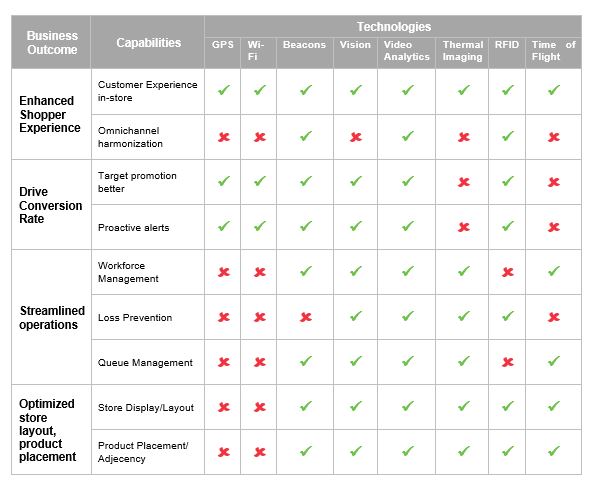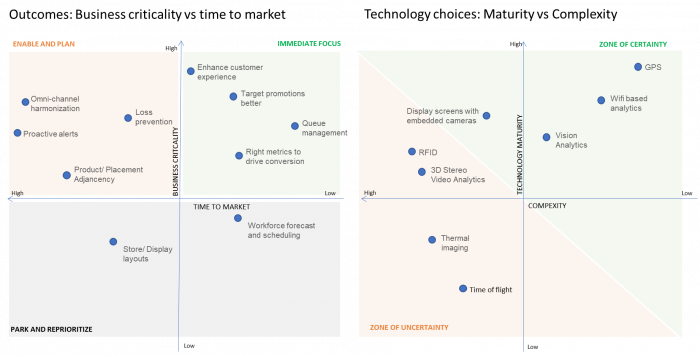By Somraj Choudhary and Jasmine Sachdeva
Now is a golden opportunity to make long-term investments
The story of in-store analytics has been a long and expensive one. Personalization and experience have emerged as key drivers of traffic and conversions with the wide-spread adoption of omnichannel commerce.
While e-commerce sites have direct access to analytics like traffic, conversion, path to purchase, and dwell time, the same cannot be said about the in-store retailers, which account for more sales worldwide. Retailers have experimented with multiple technologies like video analytics, Wi-Fi, and beacons to measure foot traffic and conversions, but have been held back by complexity, cost, and privacy challenges.
With COVID-19, we have seen significant technology adoption in order to manage store occupancy, screen temperatures, maintain social distancing, and streamlined use of facilities. Some of these adoptions are mandated by law, others were made to ensure customer safety and prevent store closures. Many of these technologies can provide the retailer with significant advantages for in-store analytics and a much better return on investment if they are seen as long-term strategic investments rather than temporary protections.
Driving tangible outcomes for retailers
In-store analytics capabilities can drive immediate and long-term benefits if retailers identify the key outcomes that can be achieved by identifying key business outcomes and aligning to future strategy imperatives.
Enhanced shopper experience
- Enhance customer experience in-store – Tracking customer behavior in-store can provide insights regarding dwell time, customer interests, trajectory, and areas of interest. These inputs can help retailers create personalized, curated experiences, and better target shoppers.
- Omni-channel harmonization – An omnichannel view of the customer’s shopping habits can better address a customer’s desires to close sales gaps. For example, if the customer did not find the right size, retailers can automatically drive towards alternate products or channels to recover the sale.
Drive conversion rate in stores
- Right metrics to drive conversion – The goal of in-store analytics is to provide the right data for each step in the process from the customer entering the store to sale to the customer’s next visit. Finding the right metrics is a low hanging fruit. These metrics formulate the right strategies based on categories and departments.
- Target promotions better – Though retailers rely heavily on promotions to generate higher returns, effective execution remains a challenge. Promotion analytics will help measure the efficacy of in-store campaigns by analyzing shopper behavior, providing intelligence to product and price management, and identifying opportunities while execution.
- Proactive alerts – Proactive alerts can be one of the ways to encourage customer engagement in-store. Alerts in the form of coupons, discounts, or recommended products can trigger new shopping behavior, help them make a better decision, and provide a more convenient, personalized shopping experience.
Streamlined Store Operations
- Workforce forecasting and scheduling – People analytics helps to measure customer’s dwell time to differentiate where in the store catches their eye compared to where they breeze by. These insights would help the retailer forecast the number of salespeople required at a particular time or place to serve customers more efficiently.
- Loss prevention – Shrinkage is eating a major chunk of the profitability in offline retail. In-store analytics can help determine the sources of losses. It takes into account the right KPIs such as security attributes, inventory data, refunds/exchanges, and points of sale data, which allows the retailers to be proactive in taking corrective actions.
- Queue Management – Having customers waiting in the queue for too long is not appropriate for any store. Analytical insights provide the data about the number of customers entering, exiting the store, the time they spend in each area, their wait time, arrival rate and service rate. With the right metrics, managers can predict and respond to the situation quickly by reallocating the associates to the required areas to eliminate the long queues.
Optimize store layout, better product placement
- Store/Display Layout – Right in-store data allows a retailer to sense the buying pattern of the shopper including when and where they go in the store, what touchpoints they interact with, and for how long. This data can be used to adjust the store layout to ease the process of finding a product in-store.
- Product Placement/Adjacency – Placing products appropriately boosts brand recognition and maximizes sales. Analyzing in-store data helps the retailer place products effectively by calculating the distance covered between the items picked from its subsequent aisles. Retailers can also leverage this data to provide appropriate up-sell and cross-sell opportunities.
Technology choices available
Many technologies are trending for gathering data for in-store analytics. The need is to identify the right ones to deliver tailored, data-driven outcomes.
Geospatial and mobile-based technologies
- GPS – GPS technology uses signals between a global navigation satellite system and a user’s GPS-enabled device to track the coordinates of an object in terms of location, speed, time, and direction. This technology is widely used for location-based marketing and reviews of nearby products, but it requires permission from the customer and a third party to share their data.
- Wi-Fi Location Analytics – Wi-Fi address is unique to each device and help seek insights into a shopper’s in-store path and buying patterns. Wi-Fi tracking is widely accepted, inexpensive, and can be easily deployed. However, it is sometimes unreliable and can raise privacy concerns. Wi-Fi requires that customers turn on the Wi-Fi service on their smartphones, which can sometimes get interrupted or lost.
- Beacons – Beacons are smart, wireless Bluetooth devices that can be attached to various things such as aisles and shopping carts. Beacons are inexpensive and easy to implement. They are a simple technology to communicate with customers inside the store but requires a shopper to download the app with Bluetooth on and permit access to their data.
Vision-based technologies
- Vision Analytics – Vision analytics identifies the patterns in images and converts them into a meaningful context, data, and action. The output of this technology is not an image but that image’s metadata. Facial recognition, product imaging, and emotion detection are also outcomes of vision technology. Retailers need to consider the nuances of consumer privacy while dealing with these technologies as privacy laws and regulations differ significantly between countries and localities.
- 3D Stereo Video Analytics –Combined with a high-resolution camera and processor, 3D stereo video analytics capture an object’s three-dimensional data. It helps to attain accurate results considering the height, width, and depth and is used to track objects. It goes beyond path analytics and head counting to also provide information on group counts and gaze direction. It will require more upfront costs as existing cameras are not installed.
- Display with embedded cameras – While there are various vision technologies to gather customer’s insights, retailers are also using cameras within display screens. These embedded cameras help the retailer to evaluate customer’s engagement by measuring the total time a customer is looking at that specific display and correlating it with the content.
- Thermal Imaging – Another technology that is gaining momentum is thermal imaging. It is capable of counting people, distinguishing an adult from a child, and is also best suited for reducing shrinkage as it can detect shoplifting. The challenge can be discerning a person’s heat emissions with the surrounding environment and the bulbs inside the sensors. The devices tend to be short-lived and expensive.
Specialized hardware
- Time of flight – Time of flight technology uses sensors to detect the time taken by light to reflect from camera to the objects. The sensor sends infrared beams at multiple directions to detect the exact positioning of objects. It helps to achieve more accurate headcount and object movement data, but the image resolution may vary.
- RFID – Radio-frequency identification uses electromagnetic waves to track and identify tags attached to the objects. It gives a more reliable real-time inventory visibility, smart shelving, efficient replenishment processes, and reduces loss prevention. RFID in itself doesn’t change the landscape for retailers, rather it requires streamlined operations, which can be an extensive time and financial investment.
Need for an integrated and business-centric approach
Businesses need to focus on integrating new approaches with existing legacy systems and methodologies. The task which isn’t as straightforward as it sounds. Each business outcome and technology is part of the puzzle, and the question is not ‘what’ and ‘when’, but ‘how.’ To make this technology effective and to obtain relevant strategic results, retailers need to follow an integrated business outcome approach.
Desired outcome vs technology matrix
Requirements for desired business outcomes may vary for different companies. The following matrix indicates how each technology can be an enabler to drive the desired outcomes.

Business criticality vs cost of technology
A big question for in-store analytics is the maturity and criticality for technology and outcomes. Given below is our approach to decision making in this area:

Let’s aim for a smart, intelligent and immersive in-store experience
The unprecedented disruption and turbulence in the current market have tested the strengths and weaknesses of global retail chains and their ability to deliver. COVID-19 will have long-term implications on business and operating models. While the fundamentals are still sound, it has created new priorities and reprioritized others. Each retailer needs to find its appropriate fit. It’s the right time to, unlock new opportunities by investing in the right combination of outcome vs technology.
Jasmine Sachdeva is a Domain Consultant in Wipro Global Consulting Group’s Retail & Distribution practice, focusing on requirement gathering, building solutions and business proposals for various retail clients across areas such as Store Operations, Customer Experience, Merchandising, etc. She holds an MBA in Retail Management and comes with a total experience of over two years within Consulting and Testing Domains.




Somraj, this was a very informative read! Retailers must constantly innovate to drive sales and stay ahead of the competition. Investing in technology is necessary for addition to streamlining store operations for a better customer shopping experience. With appropriate in-store analytics, these technologies ensure better ROI by assisting retailers in understanding customer behavior.